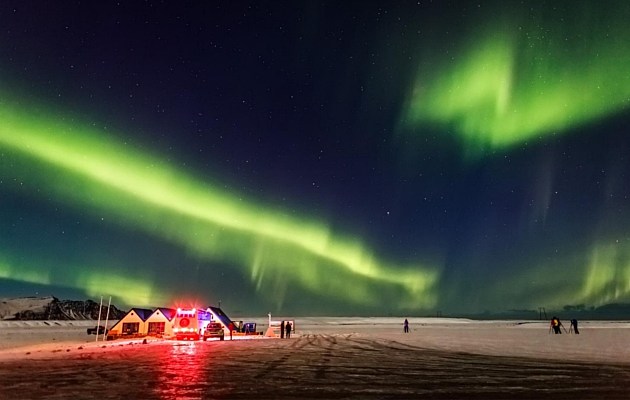
Hello, Iceland: A Tour of Recent Exports

…
The cool thing about tossing away my viable years (body: “HA!”) to dredge the new release docket on a weekly basis is seeing scenes develop in real time. It’s a fun little snapshot of how influence spreads, how a band can spark a regional fire with one catchy strum. That’s part of the reason my brows go skyward whenever someone says globalization has eradicated the unique strands of local culture. Perhaps in the capitalistic sense; if you’re trying to make it, you plot the path of least resistance which inevitably leads to a handful of American urban centers. But, I just don’t buy that all provincial quirks have been trampled and all ‘keep ________ weird’ pockets have been hurdled. In metal’s extremer environs — where ‘making it’ should be followed by self-aware laughter because. . .metal — bands are more apt to play so they may impress their chums and peers. In that vacuum, whatever gets the jaws dropping is added to the bag, regardless if it ‘makes it’ with a greater public. Then, the blown-away use the innovation as a ladder rung. After a few cycles, you have a scene.
All of this rambling is a roundabout getting in the way of stating, hey, neat things are bubbling up from Iceland. The Atlantic-located island nation has always been a hotbed for creative types, inspiring hacks such as myself to compare their bubbling creativity to the land’s volcanic activity. The pop side is streets ahead — or should we say street ahead, shout out to Ring Road Nr. 1 — and boasts the talents of Björk, Sigur Rós, and múm. (That sound is NPR swooning.) Same goes for the avant composers, counting the likes of Hildur Guðnadóttir and Jóhann Jóhannsson. Finally, and most importantly, Icelandic metal has been shipped worldwide thanks to Skálmöld and Sólstafir flying the íslenski fáninn.
Regarding the latter, those outside sales aren’t predicated on people treating their record collections like a game of Risk. People like Skálmöld because they like Skálmöld. Sólstafir speak to a universal condition. Case in point, I knew someone who said the long drive through the zilch of Arizona was best encapsulated by Sólstafir’s spaghetti downer doom. To recap, that’s a band marbled by obvious mineral deposits of Icelandic ancestry who also happen to nail the loneliness of the common I-15er. That isn’t an itty-bitty achievement. Those bands connect. However, both, similar to their aforementioned musical brethren, are undeniably Icelandic. They could exist nowhere else.
Okay, so, Iceland is fertile land for the arts and there’s a history and national sensibility supporting its more experimental exploits since the precedence has already been set. (Let them all bleat like Björk forevermore, or something.) Check. Iceland, too, has the economic factors to tend a killer crop of underground metal; that is if you believe recession breeds our best and brightest. The republic is now recovering from three years of economic devastation, a period causing Iceland’s greatest exodus of humans. The supposition: When career prospects are dim, people need to blow off steam. Stacking amps and destroying them with power chords is a fine conduit.
Of course, that’s a bit too armchair to really explain why we’re seeing an uptick in absolute bangers bearing capital city Reykjavík’s stamp. Still, the fact remains that if you enjoy brutal death metal or dissonant black metal, you’ll encounter a new Icelandic chum sooner rather than later.
The death metal side may be the more known of the two scenes, producing the tech-dexterous Ophidian I and Beneath. Both owe something to the great grand-pappies in Sororicide, an OSDM holy grail among collectors. Those fans include Aesop Dekker, who openly asked for someone to take on the task of repressing their lone long-player, The Entity.
…
…
In 2009, Sororicide reformed and issued the not-so-presciently titled Deathless, splitting for good a couple years later. Perhaps owing to its Voivod-aping-art, Deathless was a far proggier blargh, giving treming technicians a new scale to, erhm, scale. Could this be why the new school brings the widdle? One generation handing the quick pick to subsequent shredders? Slamming Lamarckism? Or was it simply that Sororicide bassist/vocalist Gísli Sigmundsson also spent time screaming for Beneath?
Yeah. If you needed another reason why I’m not metal’s Oliver Sacks, there it is.
Anyway, the membership-intermingled Ophidian I and Beneath are worth hunting down if your heart beats in gravity blasts and atypical meters. Ophidian, in particular, has a knack for knitting together the catchy with the head-spinning, not unlike the oft-invoked Anata. Beneath, while exacting the same precision, is a bigger slab of beef, hammering out reps with the ease of Magnús Ver Magnússon. They ably build upon Sororicide’s skeleton while pushing towards new plateaus.
…
…
…
Iceland’s black metal is harder to source, but it’s certainly cut from the same holy-crap-I-could-do-that cloth. It’s almost as if someone smuggled in a Deathspell Omega record and it spread like smallpox. Carpe Noctem, maybe patient zero, is the leading purveyor of these lesions. If one of black metal’s goals is to instill a sense of foreboding, Carpe Noctem is a darn fog machine. Their 2013 full-length debut, In Terra Profugus, ascended my year-end list Linda-Blair-crabwalk-style. The album was seemingly obsessed by the creepy-crawlies that skittered out of Lovecraft’s imagination, appearing to be on a first name basis with the ancient ones. Welcome to freakin’ Carcosa, indeed.
…
…
Actually, speaking of ancient, the entire record’s vibe was out of a different era. These were old phobias given a new third-wave shine, which makes some sense given that Icelanders are surrounded by history, proudly wearing the ‘son’ and ‘dóttir’ of patronymic tradition. Heck, even their native tongue is historic: Largely built upon the Old Norse languages, Iceland’s relative seclusion kept ye olde grammar intact. Neat side-effect: Icelanders can easily read the dusty manuscripts of their Norwegian forebears. I mean, I can’t exactly say the same about Chaucer. . .
Nevertheless, it’s the Icelandic way to experiment with set forms. To that end, Wormlust wiggles like the transition starting a sitcom flashback. The black holes derived from DsO suck up hope, creating a vacuum of utter bleakness. “Sex augu, tólf stjörnur,” the opener off of last year’s The Feral Wisdom, stridently screeches in the manner of a cable-less elevator hurtling to hell. Yet, amassing below the shivers of terror are warm springs of swirling Emperor-esque synth pads. It’s a teleporter screw-up where two have become one; the streams have crossed. It’s a knot more daunting than iPod earbuds ran through the wash. Product: At first it’s hard not to recoil since it’s such a shock, a real Charles Ives retooling of your noodle. Then, your mind finally untangles the mess and it clicks.
…
…
Although we’re leaving a lot of winners on the table (Svartidauði! Angist!), one can hear from this brief tour that Iceland is staking its claim as a go-to. Keep in mind, the entire country is the size of Kentucky and its largest city boasts a smidgen beyond 100,000 people, overshadowing the next closest city by 80,000. For their creative candle to burn this brightly is kind of inspiring, considering there’s not much wick to light. Naturally, if I was greeted by brain-meltingly beautiful vistas every morning, I might be able to string chugs together in an inventive way, too. True, it’s greater than that, and it’s greater than an equation built on nothing to do times economic hardship plus public schools that give a toss. Whatever, sometimes Occam’s Razor has got to rule:
Iceland is pretty darn cool!
Oof, I wrote that, didn’t I? I’ll show myself out of existence. Thanks.
…











